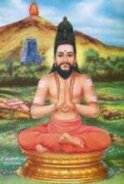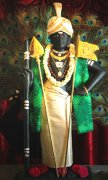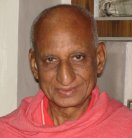

THE ESOTERIC
KANDAR ANUBHUTI
OR
THE SECRET TEACHING ON
GOD-EXPERIENCE
(A Treatise on Adwaitic Realization)
OF
SAINT ARUNAGIRINATHAR

 |  THE ESOTERIC KANDAR ANUBHUTI OR THE SECRET TEACHING ON GOD-EXPERIENCE (A Treatise on Adwaitic Realization) OF SAINT ARUNAGIRINATHAR |  |
 | by N.V. Karthikeyan |  |
| verses contents 39 40 41 42 43 44 45 46 47 48 .. 51 this verse in PDF version (8 parts) p-1 p-2 p-3 p-4 p-5 p-6 p-7 p-8 complete download of this book |
VERSE-44 சாடும் தனிவேல் முருகன் சரணம் சூடும்படி தந்தது சொல்லுமதோ வீடும் சுரர்மாமுடி வேதமும் வெம் காடும் புனமும் கமழும் கழலே.Saadum thani vel murugan saranam, Soodumpadi thanthathu chollumatho Veedum surar maamudi vethamum vem-, Kaadum punamum kamazhum kazhale. Murugan, the Great, with the destroying, Peerless Vel, Commentary The unique experience of a Jivanmukta as he emerges from that 'Pesaa Anubhuti' is portrayed in this verse. What he experienced while still immersed in that Samadhi (Verse-43) is mentioned in the first half of the verse as "Lord Murugan, with the Incomparable and vanquishing Vel, 'granted His Feet' to be crowned on my head; How can I describe this gracious act of His!" It is in the past tense. What he experiences as he emerges from that Samadhi is mentioned, in the second half of the verse, as "The Feet that shine as (or the Feet whose divine fragrance is emitting or felt in) Moksha, on the heads of the Devas, in the Vedas, in the hot forest and the millet-fields". This is in the present tense. This is the test for deciding whether an Experience is God Attainment or not -- What one experiences on emerging from any such experience -- does he feel the Presence of God everywhere? So, the experience of verse-28, however exalted, was not real God attainment, because in the next verse he himself says: 'Illeyenum Maayaiyil Ittanai, Ariyaamai poruththilai', -- 'You have involved me in this non-existent Maya; not pardoned (destroyed) my Ignorance.' Reference to the Feet is in many verses. But specific prayers were offered: (1) for the grant of the Feet to attain the 'non-thinking and non-forgetting state of Mukti' in verse-21, (2) to attain Mukti which will give freedom from Karmas in verse-35, and (3) for freedom from rebirth by attaining Liberation here and now (Jivanmukti) in verse-41. All these prayers are fulfilled in this verse. And as he emerged as a Jivanmukta, after being immersed in 'Pesaa Anubhuti' in the previous verse, the Feet that were granted are experienced everywhere -- in Moksha, on the heads of the Devas, in the Vedas, in the hot forest and the millet-fields. This is the Jivanmukta's experience of the Omnipresence of God. He experiences God everywhere -- not only as the Absolute (Moksha), but also as the relative; not only 'There' (in heaven), but also 'Here' (in the forest and millet-fields); not only 'Then' when the Feet 'were' granted, but also 'Now' on emerging from that State of Mukti. The saint says 'Kamazhum Kazhal' by which he hints that the Feet granted were not necessarily physical or visible but an Experience, a felt-presence, like the fragrance of a flower. 'Thani Vel' in verse-42, 'Murugan' in verse-43 and 'Charanam' in verse-44 -- all these 3 represent the state of Moksha. This is confirmed in this verse by mentioning these three in the same order and that the Feet shine as Moksha, etc. And whose are those Feet that were granted? Of the Lord, whose Feet adorn the heads of Devas but Whose Head is adorned with the Feet of Valli! This is an extraordinary gift of God. So he exclaims over this special favour, saying: "O! How can I describe this gracious act of His!" Again, just as the instruction of verse-37 was seen fulfilled, in Toto, in verse-42 in respect of the VEL, the instruction of verse-14: "Kaivaai Kadir Vel Murugan-Kazhal -- pettru Uyivaai" is seen fulfilled in this verse, in the same order, in respect of The FEET, as: "Saadum Thani Vel Murugan-Charanam -- soodumpadi thanthathu"! The three consecutive verses 42, 43 and 44 describe the state of Liberation, though in three different ways. Why should the attainment of the Goal be described in three verses? We do not know what the intention of Saint Arunagiri is! However, with our limited intellect, we may try to understand. It seems to be for two reasons: (1) From the beginning of the work 'Kandar Anubhuti', we find a curious mixture of verses: (a) some are invocations to the Vel, (b) some are prayers for the grant of the Lord's Feet, and (c) some are prayers to the Lord Himself. Vel (Jnana) and Lord's Feet (Bhakti) go hand in hand to show that they are the same and non-different from the Lord Himself. To fulfill all these three aspects, Saint Arunagiri seems to have chosen three verses. (a) Anubhuti or God-Realization is the theme of the work 'Kandar Anubhuti'. Murugan, the Lord/God is the Goal to be realised. In verse-2 the prayer was offered to Murugan to grant "that all-ceasing and mine-loosing 'Good'". And throughout the work reference to the Lord as 'Murugan' is in the maximum number of verses as compared to any other Name of the Lord. So, Saint Arunagiri has devoted one verse to Murugan (Verse-43) and said that the Pesaa Anubhuti was attained by the grace of Murugan. (b) In many verses, there are references and invocations to the Vel, which is identical with or non-different from the Lord, upon which an uninterrupted meditation was undertaken ('vinai odavidum KadirVel maraven') till Realization is attained, in verse-40. So, one verse is dedicated to the Vel (Verse-42). (c) Again, prayers for the grant of the Lord's Feet, which also represent the state of Mukti or Liberation, were offered in several verses, particularly in verses 21 and 35, and climaxing in verse-41 for granting protection under His Feet here and now (Immediate Liberation) (Jivanmukti). So, one verse is dedicated for the grant of the Lord's Feet (verse-44). Thus Saint Arunagiri has devoted three consecutive verses revealing the Liberation attained by the disciple. However, he chose to give importance to 'Murugan', to whom the earliest prayer was offered in verse-2 itself, and so placed verse-43 in the middle and employing the words 'Murugan' and 'Anubhuti' in it, and flanked it by the other two verses (42 and 44), to show that the Vel and the Lord's Feet are identical with the Lord and represent the state of Liberation or Mukti. (2) (a) Verse-42 details the process of meditation which leads to entering into and 'Being in' Samadhi, in which Jivatva or individuality is melted and dissolved. It is gone. (b) Verse-43 describes the State of Being Immersed in or Experiencing Samadhi (Anubhuti). Here, the Absolute alone is -- Murugan. (c) Verse-44 describes being in Samadhi and the experience while emerging from it, not as the individual which he was before but as a universal being with a universal vision, feeling the presence of God everywhere, and intent on the welfare of all. Thus the three verses describing the State of Samadhi portray the three stages: (1) of entering into Samadhi and being in it, (2) being immersed in Samadhi, and (3) being in Samadhi and emerging from it, respectively. A blessed experience -- grand and indescribable indeed! On rising from the static identity (Pesaa Anubhuti), the realised soul beholds the Lord alone everywhere and in everything - high and low, above and below, heaven and earth, Absolute and relative; and he dances in joy. The Jiva is now a Jivanmukta - one in dynamic identity with God - as a result of the Feet having been granted. The prayers of verses 21, 35, and 41 are thus, seen to be fulfilled here, in their completeness. Arunagirinathar says, "The Feet were granted." When were they granted? When the Vel was revealed (verse 42), the Feet were also granted because the two are simultaneous and non-different acts. But, he could not express it then, because at once all human faculties ceased (verse 42) and "Pesaa Anubhuti" was born (verse 43). And so, on emerging out of that Experience, he now recollects that gracious act of the Lord and exclaims over the same. Hence, this verse is at once an exclamation over, a gratitude for, and an effect of, what has been granted in verse 42. That the experience had in verse 28 is not complete realisation but only a glimpse of cosmic consciousness, while the experience of verse 43 is actual realisation, would become evident from what one feels on emerging from the respective experiences. On return to normal consciousness from that glimpse (verse-28), the Sadhaka's attitude was one of a sort of remorse, for he finds himself in (Ille ennum) Maya (verse 29), though this experience of Maya is not as bad as that of his in the earliest stage of Sadhana (verse 5). But on rising from Pesaa Anubhuti (Realization) (verse-43), he experiences a sense of joy and feels God's Omnipresence, i.e., beholds the Lord's Feet everywhere. Again, even after that glimpse, Avidya persisted (Ariyaamai Porutthilai; verse 29), whereas here Avidya gets destroyed by the grand Experience (Ariyaamai Attradhu, verse 42; and Aasaa Nigalam Thugal Aayina, verse 43). Since only the ego was swallowed up, for the time being, in that glimpse-experience of verse 28 and its root (i.e., Avidya) was not destroyed, the instruction of verse 37 was to destroy the "ego to its root", i.e., Avidya. Ariyaamai Attradhu (verse 42), Pesaa Anubhuti Piranthathu (verse 43), and Saranam Thanthadhu (verse 44) are all emphatic declarations of the attainment of the Goal. This group of verses has a special charm and significance. The Jiva (or individual) sheds its Jivatva and enters into God-being (verse 42); Experiences or becomes, i.e., be, God (verse 43); and emerges as a God-man (verse 44). This verse portrays the joy of the Jivanmukta on his rising from God-experience. These ideas are so beautifully hidden in these verses. Now the Seeker has become a Siddha Purusha, a Jivanmukta Purusha, a sage. He is no more a Jiva, an effort-center; he has attained the Goal, and there is no more need for him to do conscious Sadhana. His existence itself is Sadhana, for it becomes natural and spontaneous, his inner awareness of Reality being unbroken and steady. Evidently, that is the reason why there is no mention of Valli (who represents the Jivatman) from this verse onwards. And so there is no need for any logical sequence of thoughts hereafter, as it was upto this time. This is a simple verse in its meaning, but its implications are great and many-sided. Lord Murugan graciously offered His Feet to be crowned. This is the highest blessing conceivable, for it confers Moksha on the recipient, Feet and Moksha being the same. The Feet that are granted are those, for whose manifestation on the stony tablet of his heart he prayed (verse 6); meditation on which, while giving away one's possessions in charity, frees one from transmigration (verse 7); by obtaining which one can give up all one's desires and be saved, i.e., liberated (verse 14); the grant of which means the attainment of the non-thinking and non-forgetting state of Mukti (for which he prayed, verse 21); to bow to which feeling Satchidananda, is a great merit, difficult of attainment (verse 22); non-thinking of which, due to the coming into active play of ignorance, is verily one's destruction (to overcome which was his prayer, verse 23); which alone are not red, i.e., Perfect, but He, whose they are, is Himself red in His whole being (verse 25); the grant of which was longed for to attain the state of Mukti and be freed from Karmas (verse 35); which Brahma and other gods adorn their heads with (verse 36); and protection under which here and now means Jivanmukti, which he aspired for (verse 41). Such Feet were crowned on his head. When the Lord's Feet are granted, what happens? The bound soul at once gets liberated, the Sadhaka becomes a Siddha. To that blessed one, a new vision is opened up, as the Feet disclose their real nature. They shine as the Invisible, the visible, as well as the link between the two; as the Absolute, the phenomenal, as also that which bridges them. Arunagirinathar describes the Feet as the self-luminous state of Moksha, as shining on the heads of the Devas in heaven, as the (essence of the) eternal Vedas, as the (tender) Feet that shine in the dry forest and field. He uses the peculiar word "Kamazhum Kazhal", which does not easily lend itself to translation. It means "the sweet fragrance-wafting Feet, or the Feet that shine, or the Feet that reveal themselves." By this, what is meant is that the Feet are not necessarily visible physically, but that their divine presence is felt in a subtle way. As the fragrance of a flower cannot be seen but sensed, so are the Lord's Feet not perceived physically but felt and experienced intuitively, by the realised soul. This is the significance of "Kamazhum" (shine or emit fragrance). Again, while the act of granting the Feet is in the past tense, as "granted" (Thanthathu), the Saint has used the present tense as "shine" (Kamazhum), in describing the nature of the Feet so granted. This also indicates that the Feet are not merely those that were placed on the heads of gods or walked over the forest and field in search of Valli, then, but that they are a living presence to the liberated ones. The mention of a few places where the Lord's Feet shine is only symbolic, and is meant to suggest their omnipresence. Arunagirinathar's selection of places is significant. Let us see where and how the Lord's Feet shine. Moksha is the Goal of all human aspiration, attaining which life's purpose is fulfilled. It is the consciousness of Absolute freedom (Liberation). It is called Parama-pada - the Supreme Abode. It is the Divine Feet of the Lord. The Lord's Feet themselves shine as the very state of Moksha and Moksha stands for the Absolute. The Lord's Feet shine on the heads of the Devas. The Eternal and the Formless manifested Itself as Lord Skanda to alleviate the sufferings of the Devas. When the Asura Surapadman, under whose tyranny the Devas were suffering, was vanquished by the Lord, all the Devas worshipped Him and placed His Feet on their heads as a mark of respect and gratitude. Thus, His Feet shine on the heads of the Devas, i.e., in heaven. Those Feet which shine as the Absolute also shine in and as the higher regions (heaven). The Feet do not merely shine as the Absolute and the higher regions, they are also the means of attaining them - the Vedas. The Vedas are the repository of wisdom. They are regarded as Apaurusheya, i.e., not man-made or composed by men, but as the revelations of the Supreme Being itself. The Vedas are not the written books but the wisdom Eternal, the ecstatic outpourings of the revelations of men of realisation. They have come down to us through the Guru-disciple tradition of hearing and reciting. Hence, the Vedas are called as Sruti (what is heard or revealed) as distinguished from Smritis which are the works of human origin. The Vedas extol God and exhort men to seek perfection. They are replete with Upasanas and Vidyas (meditations) of different kinds which are capable of bestowing upon the practitioner heaven as well as Moksha. As the Vedas are revelations of the Supreme Being and as they serve as means of attaining heaven or Moksha, they are regarded as the Feet of the Lord. The Lord's Feet, thus, shine as the Vedas. The Feet which shine as the Absolute and in the higher regions, shine as the Vedas also to serve as the means of attaining them. This vast universe is the field created by God for the Jivas to undergo different experiences and thus evolve and finally attain Him. When the souls are ripe, drawn by their devotion, God manifests Himself on this earth plane to grant them Mukti. Valli's devotion drew Lord Skanda from His Abode to the millet-fields and the hot forest, over which He walked in search of His beloved. This is Skanda-Lila - the playful divine sport of Lord Skanda. The whole of creation, of which the earth is the immediate object of our experience, is at once a field for the Lord's play and the Jiva's experience. It is the sporting ground and meeting place of Jiva and Isvara. This is so beautifully and symbolically brought out by Arunagirinathar in saying that the Lord's Feet shine in the hot forest and fields, as it is here that the Lord met Valli and accepted her. The Vedas say, God sacrificed Himself and became this universe, which is one Paada (foot) i.e., one-fourth, of the Supreme Being, three-fourth being Immortal and Eternal. The Lord's Feet shine as this universe. Thus, as the Absolute, in the higher regions, as the Vedas and on the earth - the Lord's Feet shine everywhere. His Feet are the base, the means, and the end. By all this, Arunagirinathar brings out the Omnipresence of God, which is felt by the (realised) soul that is blessed with the Feet. When the Lord grants or confers His feet on one's head, one gets the cosmic vision of the Feet and beholds them everywhere. Though the act of placing the Feet may be done once, its effect of beholding them everywhere persists forever, because the Feet-grant means also Vel-revelation, which is an inner state of consciousness. Hence, Arunagirinathar uses the past tense for the act of granting the Feet, as "granted" (Thanthathu), but uses the present tense while describing the nature of the Feet that were so granted, as "shine" (Kamazhum). So much regarding the glory of the Lord's Feet! What about His Vel? It is also equally great. We have seen earlier that the Feet and the Vel go together and that they are identical. This truth is so beautifully brought home in this verse where the Vel also is glorified by two epithets - "Saadum" and "Thani", i.e., "vanquishing" and "Incomparable" - to indicate its relative and Absolute aspects. The Vel is Incomparable; it is the Absolute; it is identical with the Lord Himself; it is Pure Consciousness, as seen in verse 40. The "Incomparable" ("Thani"), therefore, refers to the Absolute aspect of the Vel. But it is not merely that; it is also the relative, it is "destroying", too. The Vel destroys what? It vanquished the proud Asura Surapadman with his kith and kin, and brought freedom to the Devas. The Asuras are the external enemies and are symbolic of the inner foes of the Sadhaka - Avidya, Kama, and Karma, which the Vel destroys. It manifests itself as Sadhana-Sakti, as the needed subtle understanding to pierce through Avidya. This "destroying" ("Saadum") is the Vel's relative aspect. And when ignorance is thus destroyed, it stands as Pure Consciousness. It manifests itself as the means of removing Avidya and when it is done, it remains by Itself as the Goal attained. The Vel is, thus, both the means as well as the End; the relative and the Absolute; dynamic as well as static; "Saadum" (destroying) and "Thani" (Incomparable). It is in this rare verse that both the relative and Absolute aspects of both the Vel and the Feet are beautifully blended, with a specific intention, viz., to suggest that it portrays the condition of the realised soul (Jivanmukta). Only he has the unique privilege of a simultaneous experience of both the relative and Absolute aspects of Reality. Swami Sivananda says in his work 'Guru Tattwa': "The Guru is verily a link between the individual and the Immortal. He is a being who has raised himself from this into That, and thus has a free and unhampered access into both the realms. He stands, as it were, upon the threshold of immortality; and, bending down he raises the struggling individuals with his one hand, and with the other lifts them up into the imperium of everlasting joy and infinite Truth-Consciousness." In the state of Samadhi (verse 42), the Vel is experienced as only the "Thani" (Incomparable) and the Feet as only the "Neri" (Moksha) - i.e., their Absolute aspects. On rising from Samadhi, as a Jivanmukta, they are experienced (as in this verse) in both their aspects - the Vel as not only the "Thani" but also as "Saadum", and the Feet as not only Moksha ("Veedu") but also as the field and forest (physical plane) - i.e., in their Absolute and relative aspects. Thus, this verse makes clear that in the Vel-revelation of verse 42 is implied the Feet-grant also. But, while verse 42 is the experience of Samadhi, this verse is that of Jivanmukti. The Vel-revelation of verse 42 and the Feet-grant of this verse are identical; they mean the same thing; i.e., the attainment of Mukti (Liberation). In verse 42, the state of Mukti ("Neri") was identified with the Vel, as "Neriyai" and "Velai". Now, the same Mukti ("Veedu") is identified with the Feet. The Vel-revelation and the Feet-grant are, therefore, simultaneous occurrences, though the former may be regarded as an inner awareness while the latter an external act. In verse-21 the prayer was for the grant of the Feet, for attaining the state of non-thinking and non-forgetting (Karutha maravaa neri) i.e., Mukti. In verse-42 'Kuriyaik kuriyaadu kuriththu ariyum Neri' is the 'Thani Vel', which is also Mukti. This shows that the Lord's Feet and the Vel both mean Mukti. While the uninterrupted meditation undertaken is on the Vel (verse 40), what is aspired to attain are the Feet (verse 41); while the prayer of verse 41 is, thus, for protection under the Feet, what is granted (or revealed) in response, in verse 42, is the Vel; and while the Vel is revealed in verse 42, what is wondered at as having been granted are the Feet (verse 44). How interchangeably does Arunagirinathar refer to the Vel and the Feet, to suggest their identity or non-difference! And to confirm this, in this verse, he brings the Vel and the Feet together, as "the Feet of the Lord Muruga who has the destroying, Incomparable Vel", in both their relative and Absolute aspects. The state of knowing by thinking-without-thinking (verse 42) and the Speechless-experience (verse 43) maybe regarded as static identity with God; i.e., actual experience of Samadhi, wherein all faculties cease. That one does not remain in that Pesaa Anubhuti (or state of Samadhi) but rises from it, and that even on emerging from it his "contact" with God is not severed but that he beholds Him everywhere is mystically disclosed by this verse (verse 44). Hence, the condition described in this verse may be regarded as one of dynamic identity, i.e., the experience of a Jivanmukta on emerging out of the Samadhi-experience. Only those blessed souls that come down from the zenith of God-experience can guide the world. They are the rare ones who are vested with a divine command as also the needed extraordinary power to fulfill the divine mission. This is seen in the lives of such great souls as Ramakrishna Paramahamsa, Ramana Maharishi, Swami Sivananda and many others. Thus, though the meaning of the verse is simple, its implications are profound and many-sided. |
| contents 39 40 41 42 43 44 45 46 47 48 .. 51 this verse in PDF version (8 parts) p-1 p-2 p-3 p-4 p-5 p-6 p-7 p-8 |
| ... www.kaumaram.com ... The website for Lord Murugan and His Devotees முகப்பு கௌமாரம் அட்டவணை மேலே தேடல் home Kaumaram contents top search |
Kaumaram.com is a non-commercial website. This website is a dedication of Love for Lord Murugan. Please take note that Kaumaram.com DOES NOT solicit any funding, DIRECTLY or INDIRECTLY. |